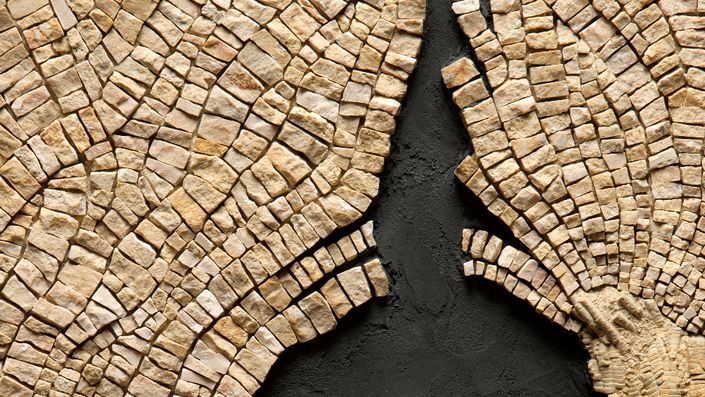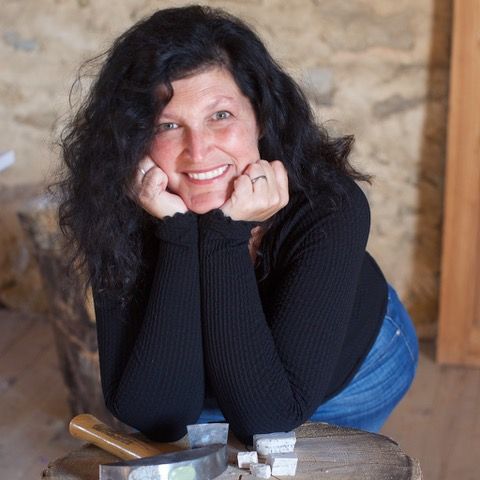
Classical Andamento in Modern Mosaics with Anabella Wewer
Lessons in hammer and hardie techniques, classical andamento rules and their application to modern mosaics. Drawing andamento and a primer on color gradation.
Watch Promo Enroll in Course
In this very comprehensive online course, Anabella Wewer walks students through four different elements for creating mosaic art. This course is for you if you are looking to refine your mosaic skills, interested in working with a hammer and hardie, are wanting to learn drawing and understanding andamento, and hoping to use color gradation. The course will give you a very up close birds-eye-view of how to use the hammer and hardie. You will also learn everything from the proper choice of stumps, lessons on how to stand or sit with the best ergonomics and posture, and how to create the best cuts (straight or angled) of stone, marble, or smalti. Anabella goes in-depth about andamento, and uses simple language to instruct on creating lines while developing individual styles of mosaic art. Anabella demonstrates drawing by tracing her own work. This technique is used to help improve the skills that eventually will be needed for creating andamento drawings. She also shares her knowledge on the basics of how to create a color gradation using smalti and some stone, Anabella breaks down the mystery of how one can use gradation to create an array of mosaic art. Lastly, in order to help students understand the use of andamento, she uses two sections to discuss andamento and color choice through the work of other mosaic artists.
Your Instructor

A graphic designer by profession, and a native of Caracas, Venezuela, Anabella is an internationally exhibited mosaic artist and passionate metalsmith. She is co-founder, and has been Creative Director of Black Box, a studio specializing in Web-based applications, since 1994. After discovering mosaics as fine art during a trip to the Vatican in 2004, she started taking mosaic classes in the United States, but quickly made the decision to train mostly in Italy. Her work is rooted in a sense of place and time, with a distinctive graphic feel that often incorporates type and her love of maps and fossils. Her passion for materials and history inform her work and push her to explore new territory grounded in time-proven rules and principles. Her background as a typographer guides her work, exploring the language of materials and technique to tell stories. "When I put hand to metal or stone, I aim to bring the viewer into a narrative, to provide questions to consider. I am intrigued by frozen moments in time; I like to imagine what came before and what follows. Place and time, their changing and their passing, and trying to capture their impermanence is my main artistic directive,” says Anabella of both her jewelry and mosaic work.
Anabella has studied Ravenna mosaic technique with Luciana Notturni, in Ravenna, Italy; stone micro-mosaic and opus vermiculatum with Arianna Gallo and Luca Barberini of Koko Mosaico in Ravenna; filati micro-mosaics with Maestro Carlo Meloni (Rome); abstract and modern mosaics with Verdiano Marzi (Ravenna/Paris), Dugald MacInnes (Scotland), Matteo Randi (Ravenna) and Dino Maccini (Piacenza) as well as with Valeria Manzo, Dagmar Friedrich and Laura Carraro at the Scuola Mosaicisti dei Friuli, Spillimbergo; and honed her skills using native materials with Rachel Sager; color in mosaics with Carol Shelkin, and got her beginnings under the guidance of Gina Hubler (Pennsylvania). Her native languages are Spanish and Portuguese, and she also speaks English and Italian. She lives in Macungie, Pennsylvania.
Course Curriculum
-
StartIntroduction and personal interview with Tami and Anabella (5:06)
-
StartDownloadable PDF with all the tools, materials and resources.
-
StartIntroduction to hammer and hardie. (0:14)
-
StartSelecting a stump for the hardie. (1:38)
-
StartHardie overview. (1:35)
-
StartDiscussing the hammer, including the weight, tips and proper handle length. (7:53)
-
StartPosture for successful cuts. (1:00)
-
StartErgonomics: Standing and seated positions with hammer and hardie (2:32)
-
StartThe mechanics of cutting. (2:10)
-
StartStraight, curved and angled cuts. (4:20)
-
StartDetailed view of hammer and hand positioning. (0:24)
-
StartCutting marble and other materials. (6:34)
-
StartCutting Smalti. (3:04)
-
StartCorrecting and refining cuts and cutting trapezoids (keystones). (6:40)
-
StartThings that can go wrong. Take two-with the correct edge. (1:22)
-
StartAndamento Part 1. (7:53)
-
StartAndamento Part 2 (4:07)
-
StartAndamento Part 3: Triangles and Sdoppiamento. (6:48)
-
StartAndamento in modern mosaics. (5:48)
-
StartSelecting materials and how that affects design decisions: marble specific considerations. (4:44)
-
StartUnderstanding and working with man-made materials. (1:38)
-
StartUnderstanding and working with Italian smalti. (6:40)
-
StartCreating narrative through material selection and scale. (7:38)
-
StartMaterial selection and scale as part of design, continued. (4:19)
-
StartDrawing and tracing andamento for understanding movement, scale and interstices. (5:25)
-
StartIntroduction to color gradation. (7:36)
-
StartStudying finished work to understand andamento, gradations and design choices. Part 1. (8:47)
-
StartStudying finished works. Part 2. (10:35)
Frequently Asked Questions
TESTIMONIAL:
“I just found this website, Mosaic Arts Online, through a workshop posting site. I’m about to embark on a hammer and hardie project of which I’ve done before with minimal instruction. I can’t fly to London or Italy or Chicago, but I wanted to know more. Up until now, I’ve just looked at some work and tried to learn that way.
So I searched this site, Mosaic Arts Online, and found an absolutely awesome instructional video ‘Classical Andamento in Modern Mosaics with Anabella Wewer’. You have to buy the online course, but it gives you 100 percent access to look at it over and over as you progress.
As a person who’s only done mosaics for three years at a local art center, this site gives me the ability to access many professionals in areas I want to know more about. When you combine this wonderful site with exceptional artists who share their experiences, and online sites such as this, who knows what might be created.” Mary Ellen B